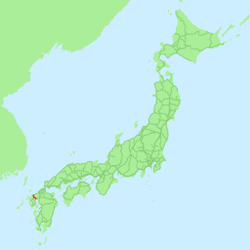Karatsu Line
The Karatsu Line (唐津線, Karatsu-sen) is a regional railway line in Saga Prefecture, Japan, owned and operated by Kyushu Railway Company (JR Kyushu). It connects Kubota in Saga City to Nishi-Karatsu in Karatsu City, both in Saga Prefecture, Japan.[1] The line was originally constructed to carry coal from the Karatsu coal fields to the Port of Karatsu for export and had many branch lines to coal mines which have since closed.[2][3]
| Karatsu Line | |||
|---|---|---|---|
| Overview | |||
| Type | Regional rail | ||
| Locale | Saga Prefecture | ||
| Termini | Kubota Nishi-Karatsu | ||
| Stations | 13 | ||
| Operation | |||
| Owner | JR Kyushu | ||
| Technical | |||
| Line length | 42.5 km (26.4 mi) | ||
| Number of tracks | Single | ||
| Track gauge | 1,067 mm (3 ft 6 in) | ||
| Electrification | 1,500 V DC, overhead catenary (Karatsu to Nishi-Karatsu) | ||
| |||
Stations
| Station | Japanese | Distance (km) |
Connecting lines | Location | |
|---|---|---|---|---|---|
| Kubota | 久保田 | 0.0 | Nagasaki Main Line | Saga | Saga Prefecture |
| Ogi | 小城 | 5.1 | Ogi | ||
| Higashi-Taku | 東多久 | 10.6 | Taku | ||
| Naka-Taku | 中多久 | 13.6 | |||
| Taku | 多久 | 15.2 | |||
| Kyūragi | 厳木 | 20.8 | Karatsu | ||
| Iwaya | 岩屋 | 23.3 | |||
| Ōchi | 相知 | 26.0 | |||
| Honmutabe | 本牟田部 | 30.1 | |||
| Yamamoto | 山本 | 32.9 | Chikuhi Line (Western section) | ||
| Onizuka | 鬼塚 | 36.6 | |||
| Karatsu | 唐津 | 40.3 | Chikuhi Line (Eastern section) | ||
| Nishi-Karatsu | 西唐津 | 42.5 | |||
Rolling stock
- KiHa 40/47 DMUs
- KiHa 125 DMUs
- 103 series EMUs
- 303 series EMUs
- 305 series EMUs
History
The Karatsu Kogyo Railway opened a line from Myōken (妙見) (today Nishi-Karatsu to Yamamoto in 1898, on an alignment paralleling the west bank of the Matsuura River, and extended the line to Taku the following year. In 1902, the company merged with the Kyushu Railway Co., which extended the line to Kubota in 1903. The company was nationalised in 1907. From 1898 to 1912, a number of freight only branch lines were also built.[4]
The Chikuhi Line from Higashi-Karatsu was extended to Yamamoto in 1929 on an alignment paralleling the east bank of the Matsuura River.[5][6]
In 1983, the Chikuhi line was rebuilt so it branched at Karatsu,[5] with the Karatsu - Nishi-Karatsu section being electrified at 1,500 V DC at the same time in conjunction with the electrification of the Chikuhi line, together with CTC signalling from Nishi-Karatsu to Kubota.
The last of the freight only branch lines closed in 1982. Freight services ceased in 1986.[4]
References
- "JR Kyushu Route Map" (PDF). JR Kyushu. Retrieved 3 March 2018.
- JR Kyushu (2013). JR九州のひみつ [Secrets of JR Kyushu] (in Japanese). PHP Institute, Inc. p. 84. ISBN 9784569814933.
- Imao, Keisuke (2009). 日本鉄道旅行地図帳 12号 九州 沖縄―全線・全駅・全廃線 [Japan Rail Travel Atlas No. 12 Kyushu Okinawa - all lines, all stations and disused lines] (in Japanese). Mook. pp. 22, 54. ISBN 9784107900302.
- Ishino, Tetsu; et al., eds. (1998). 停車場変遷大事典 国鉄・JR編 [Station Transition Directory - JNR/JR] (in Japanese). I. Tokyo: JTB Corporation. pp. 223–4. ISBN 4533029809.
- Ishino, Tetsu; et al., eds. (1998). 停車場変遷大事典 国鉄・JR編 [Station Transition Directory - JNR/JR] (in Japanese). I. Tokyo: JTB Corporation. p. 225. ISBN 4533029809.
- Imao, Keisuke (2009). 日本鉄道旅行地図帳 12号 九州 沖縄―全線・全駅・全廃線 [Japan Rail Travel Atlas No. 12 Kyushu Okinawa - all lines, all stations and disused lines] (in Japanese). Mook. pp. 22, 41–2. ISBN 9784107900302.

.svg.png)